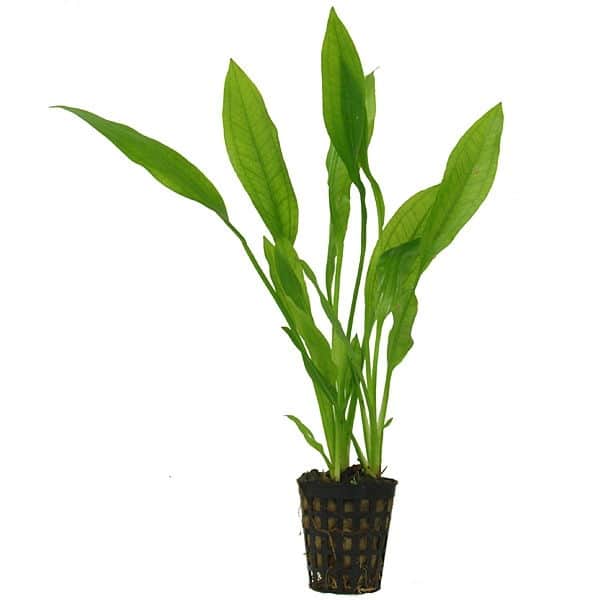Once upon a time, two young amazon boys wondered down to the river. Paleo and Parvi looked in awe at the sun streaming through the canopy above into the slowly trickling tepid water. The shores of the river were covered in masses of vegetation of every texture and hue of green imaginable. They stood by the shore of the river skipping stones across the water, wondering where their mothers and fathers selected their odd names. The long sinewy vines hung with a supple velvetness from the canopy above while the hard silvery Arowana’s erupted from the water in search of birds in the trees. They peered at the village girls glistening in the suns rays, bathing their dark bodies in the water upstream…sorry folks, lost my head there for a minute. This is supposed to be a plant article!!
The following article will discuss the propagation of Echinodorus parviflorus and Echinodorus paleofolius. These are two varieties of Amazon sword plants with some very distinct differences. Echinodorus paleofolius is more of your typical Amazon sword in that it has the standard leaf shape submersed which is long and lanceolate. The leaves are 2-3cm [1″] wide and reach up to 20 –30 cm [8-12″] long if kept below the water surface. When the leaves grow out of the water (emersed) they become more oval in shape and can easily exceed 10cm [4″] in width and 20cm [8″] in length. There are distinct horizontal veins in the emersed leaves that become somewhat more subdued when below the water surface.
The root structure and the corm are fairly substantial as they are in most Echinodorus species. I propagated this species by cutting the mother plant into two separate plants. In the process of cutting, the corm was cut as well so as to ensure both plants had a section of corm and roots attached. Experience with the Echinodorus plants shows that if you prune or clip the leaves above water the plant will remain submersed and widen out below the water. This is definitely the case with Echinodorus paleofolius as it explodes nicely when the plant grows out of water.
The paleofolius was propagated in an open-top 15 gallon aquarium with 2×20 watt fluorescents mounted about 5” above the tank. The temperature was 26º Celsius [79ºF] and pH at 7.0. The 15-gallon tanks are only 12” high so the plant did very well in the high light zone. Echinodorus paleofolius is native to Brazil in South America and grows in the Amazon River system. This is a great plant for a beginner and makes a good background plant in a small tank or a mid-ground plant in a larger tank.
The Echinodorus parviflorus is a cultivar. It is not found in the form available to aquariasts in the wild. The plant is cultivated and sold by Tropica Aquarium Plants, Denmark. It is really a nice small sword with some very distinctive features. The leaves are oval in shape and quite compact in size. My specimens were about 2-3cm [1″] wide and 5 cm [2″] in length. The dark green color combined with a hammered effect (sounds like Hopper on a Friday night) on the leaves, which looked like slight depressions, and raised areas on the leaf were very attractive. This is truly a foreground plant for the aquarium and is relatively undemanding from a care perspective. The Echinodorus parviflorus only reaches heights of 10-15 cm [4-6″] and looks best when planted in groups amongst some rock or wood.

The specimen I had sent a runner across the tank, which ended up with 3 plantlets growing from the runner. I clipped the runner from the mother plant and the remaining plantlets did very well as they already had sent down roots into the substrate and were comprised of 8-10 small leaves each. Propagation by runner with Echinodorus species is one of two methods discussed in this article to reproduce these great plants. They can also be reproduced by seeds from flowerings or by making small nicks in the corm, which will produce new plantlets from the corm itself.
The aquarium that the Echinodorus was propagated in was a 108-gallon tank with 4×40 watt fluorescents and CO2 injection. The tank is only 18” deep so the light is quite intense on the lower levels. This caused the echinodorus to bush out nicely and not reach for the light as some swords have a tendency to do. Echinodorus parviflorus is a great little sword plant that I highly recommend for any aquariast.
With the completion of this article, I have achieved my Grand Masters in Aquatic Horticulture. The first plant I did was Red Ludwigia in October 1992. I have now successfully propagated 91 species of plants and it has been a great learning experience. Highlights include everything from failing duckweed 3 times to flowering Madagascar Lace plants. I encourage any aquariast to join the HAP or BAP program. You’ll meet lots of people and learn things that you never find from other sources. I would like to take the opportunity to not only thank the club but also especially thank Bill Bishopp for all the verifications he has done and the many discussions that we have had regarding plants as well as Rudy Kearn, a great guy, and major plant enthusiast from Edmonton for all the specimens and inspiration. As Rudy so aptly said “ I have never met an aquatic plant I didn’t like”.
Leave a Reply